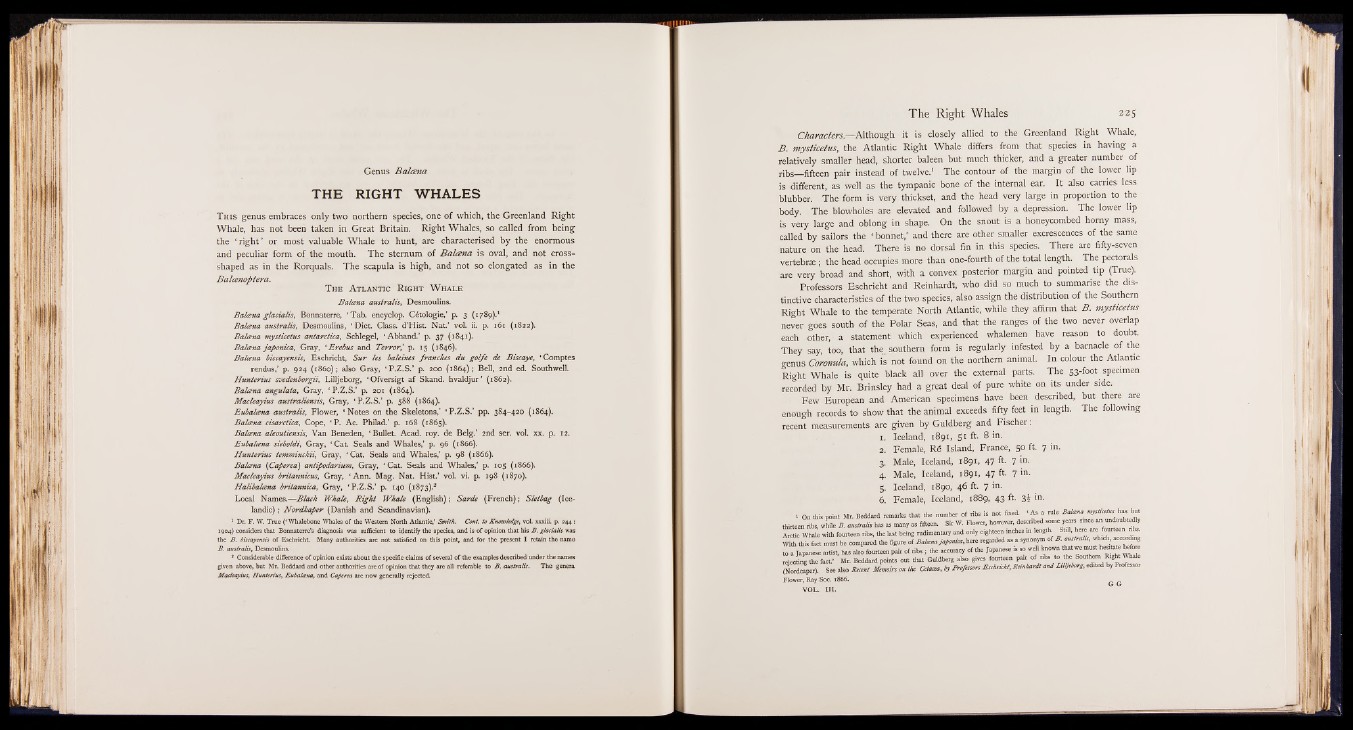
Genus Balcena
THE RIGHT WHALES
T his genus embraces only two northern species, one of which, the Greenland Right
Whale, has not been taken in Great Britain. Right Whales, so called from being
the ‘ right’ or most valuable Whale to hunt, are characterised by the enormous
and peculiar form of the mouth. The sternum of Balcena is oval, and not crossshaped
as in the Rorquals. The scapula is high, and not so elongated as in the
Balcenoptera.
T he A tlantic Right W hale
Balance australis, Desmoulins.
B alana g la cia lis, Bonnaterre, ‘ Tab. encyclop. C6tologie,’ p. 3 (1789).1
Balcena australis, Desmoulins, ‘ Diet. Class. d’Hist. Nat.’ vol. ii. p. 161 (1822).
B alana mysticetus antarctica, Schlegel, ‘ Abhand.’ p. 37 (1841).
B alana japonica, Gray, ‘ Erebus and T erro rl p. 15 (1846).
B alana biscayensis, Eschricht, S u r les baleines f ranches du g o lfe de Biscaye, 'Comptes
rendus,’ p. 924 (i860); also Gray, ‘ P .Z .S.’ p. 200 (1864); Bell, 2nd ed. Southwell.
H unterius svedenborgii, Lilljeborg, ‘ Ofversigt a f Skand. hvaldjur’ (1862).
B alana angulata, Gray, ‘ P.Z.S.’ p. 201 (1864).
M acleayius australiensis, Gray, ‘ P.Z.S.’ p. 588 (1864).
Eubalana australis, Flower, ‘ Notes on the Skeletons,’ ‘ P .Z .S.’ pp. 384-420 (1864).
B ala n a cisarctica, Cope, ‘ P. Ac. Philad.’ p. 168 (1865).
B ala n a aleoutiensis, Van Beneden, ‘ Bullet. Acad. roy. de Belg.’ 2nd ser. vol. xx. p. 12.
Eubalana sieboldi, Gray, ‘ Cat. Seals and Whales,’ p. 96 (1866).
H unterius tem m inckii, Gray, ‘ Cat. Seals and Whales,’ p. 98 (1866).
B alana {Capered) antipodarium, Gray, ‘ Cat. Seals and Whales,’ p. 105 (1866).
M acleayius britannicus, Gray, ‘ Ann. Mag. Nat. Hist.’ vol. vi. p. 198 (1870).
H alibalana britannica, Gray, ‘ P.Z.S.’ p. 140 (1873).2
Local Names.— B la ck Whale, R ig h t W hale (English); Sarde (French); Sletbag (Icelandic)
; Nordkaper (Danish and Scandinavian).
1 Dr. F. W. True (‘ Whalebone Whales of the Western North Atlantic,’ Smith. Cont. to Knowledge, vol. xxxiii p. 244:
1904) considers that Bonnaterre’s diagnosis was sufficient to identify the species, and is of opinion that his B . glacialis was
the B . biscayensis of Eschricht Many authorities are not satisfied on this point, and for the present I retain the name
B . australis, Desmoulins.
* Considerable difference of opinion exists about the specific claims of several of the examples described under the names
given above, but Mr. Beddard and other authorities are of opinion that they are all referable to B . australis. The genera
Afacleayius, Hunterius, Eubalana, and Caferea are now generally rejected.
Characters.— Although it is closely allied to the Greenland Right Whale,
B . mysticetus, the Atlantic Right Whale differs from that species in having a
relatively smaller head, shorter baleen but much thicker, and a greater number of
ribs— fifteen pair instead of twelve.1 The contour of the margin of the lower lip
is different, as well as the tympanic bone of the internal ear. It also carries less
blubber. The form is very thickset, and the head very large in proportion to the
body. The blowholes are elevated and followed by a depression. The lower lip
very large and oblong in shape. On the snout is a honeycombed horny mass,
called by sailors the ‘ bonnet,’ and there are other smaller excrescences of the same
nature on the head. There is no dorsal fin in this species. There are fifty-seven
vertebrae ; the head occupies more than one-fourth of the total length. The pectorals
are very broad and short, with a convex posterior margin and pointed tip (True),
Professors Eschricht and Reinhardt, who did gg much to summarise the distinctive
characteristics of the two species, also assign the distribution of the Southern
Right Whale to the temperate North Atlantic, while they affirm that B . mysticetus
never gdes south of the Polar Seas, and that the ranges of the two never overlap
each other, a statement which experienced whalemen have reason to doubt.
They say, too, that the southern form is regularly infested by a barnacle of the
genus Co'ronula, which is not found on the northern animal. In. colour the Atlantic
Right Whale is quite black all over the external parts. The 53-foot specimen
recorded by Mr. Brinsley had a great deal of pure white $$ its under side»!,
Few European and American specimens have been described, but there are
enough records to show that the animal exceeds fifty feet in length. The following
recent measurements are given by Guldberg and Fischer.
1. Iceland, 1891, 51 ft- ® ln-
2. Female, Rd Island, France, 50 ft. 7 in.
3. Male, Iceland), 1891, 47 ft. 7 in.
4. Male, Iceland, 1891, 47 ft. 7 in.
5. Iceland, 1890, 46 ft. 7 ln-
6. Female, Iceland,¥ii889, 43 ft. 3* in.
. 0» t o point Mr. Beddard remarks that the number of ribs is riot fined. ■ As a t o t o mysticetus has but
thirteen ribs, while B . australis has as many as «teen. Sir W. Flower, however, desenbed » » « I » since an undoubtedly
Arctic Whale with fourteen ribs, the last Being rudimentary and only eighteen inches in length. Soil, h^re are fourteennbs.
-vtith this (act must be compared the figure of Balana jafoniea, here regarded as a synonym of B . australis,H i which, acc^rng artist, has also^rteen ,S r o f ribs ; die aecumcy of the Japanese is so wed known t o t we must he t o e before
r e ie c to d ie fact' Mr. Beddard points out that Guldberg also gives fourteen pan of nbs to foe Southern Right Whale
(Nordcaper). See also Recent Memoirs on the Cetacea, b Professors Eschricht, Reinhardt and Ltlljtborg, edited by Professor
Flower, Ray Soc. 1866. ^
VOL. III.